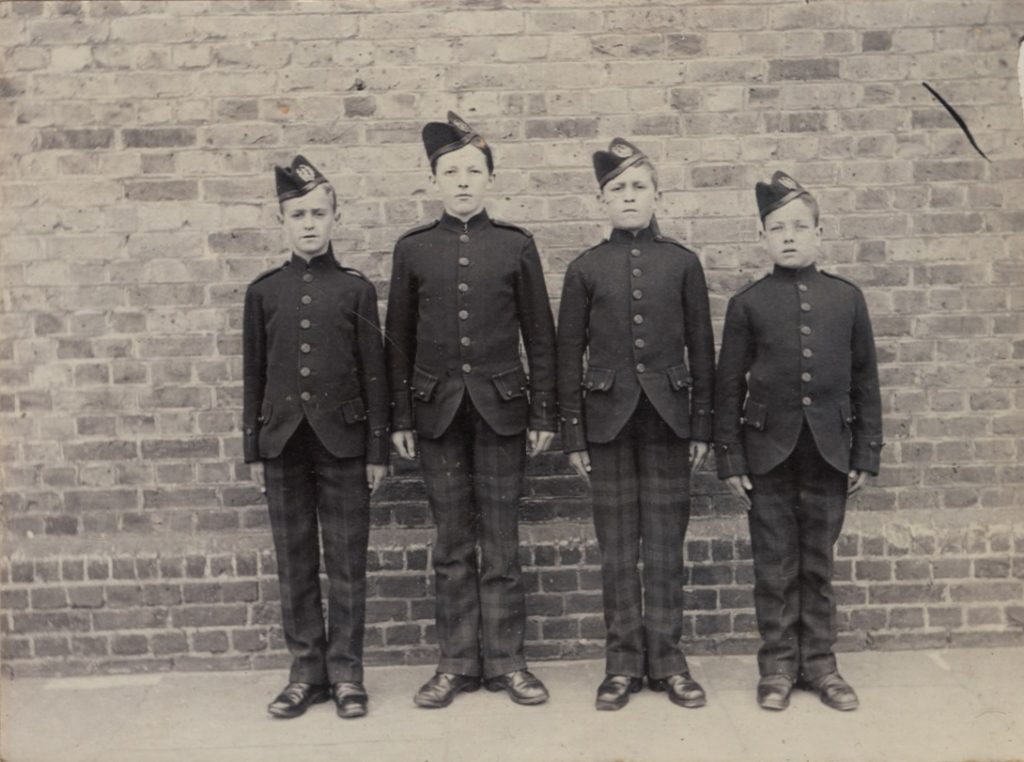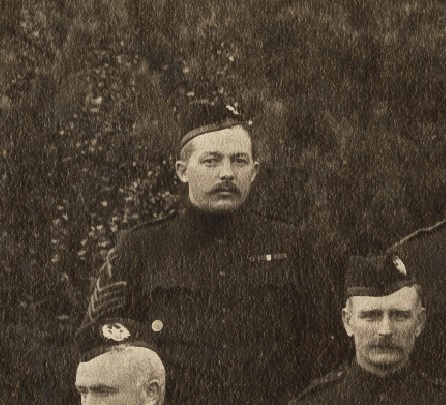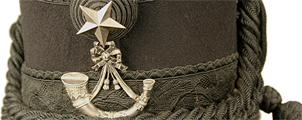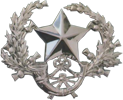“The Four Youngest Cameronians” 1891
A recent enquiry concerning a photograph on display in Low Parks Museum prompted me to look into the photograph in more detail, and see what information, if any, we could learn about “The Four Youngest Cameronians”. The original photograph is contained within a regimental photograph album; a check of the album page showed that the surnames of the boys had been written in pen, underneath the photograph. Sadly, many of the photographs in the regimental collection fail to record the names of those shown, so it was fortunate in this case that the boys had been named, and the date on which the photograph was taken had also been recorded.

“The Four Youngest Cameronians” 1891
The image has been captioned as “The Four Youngest Cameronians” and the individuals are named, left to right, as Boys ‘Banks’, ‘Baldock’, ‘Banks’, and ‘Chamberlain’. The photograph was taken on 8th July 1891. ‘Boy’ was the rank used by the Army for young soldiers under the age of 18.
The photograph is interesting as the Boys are wearing Government Tartan trews as opposed to the Douglas Tartan that we generally associate with The Cameronians (Scottish Rifles). Permission was granted by Queen Victoria in May 1891 for the Regiment to adopt the use of Douglas Tartan, but this did not come into effect until 1st April 1892.
Looking at the names, the somewhat unusual name of Baldock jumped out as familiar, and doing a quick check of our other collections I found that he was named in another image in the museum collection. Amazingly, I also found a record in our Regimental Enlistment Registers (1919-1934) for a William J H Baldock, who had enlisted at Cork on 11th December 1890, aged 14. The entry would suggest that William Baldock had served in the Regiment continuously from December 1890 until his retirement as Regimental Sergeant Major in January 1922. He had served in the Boer War, and the First World War, and had been awarded the Queen’s and King’s South Africa Medals, the 1914-15 Star, British War Medal and Victory Medal, and also the Long Service and Good Conduct Medal.
There were no obvious matches for the other names in the Enlistment Registers, so I assumed that both Banks Boys and Boy Chamberlain had left the Regiment before the enlistment books commenced in 1919. Time to go to the local library to see what information I could find on Ancestry.com (if you don’t have a membership for Ancestry it is worth checking with your local library as many provide free access).
Working on the assumption that all the boys were around the same age as William Baldock, I was able to find service records for an Alfred Ernest Banks, an Edward William Banks, and a Charles Alfred Chamberlain. Alfred Banks joined the 1st Battalion at Cork on 9th January 1891, aged 14 years and two months. Edward Banks joined at Aldershot on 30th June 1891, aged 14 years. Charles Chamberlain also joined at Aldershot, on 1st July 1891, aged 14 years. The 1st Battalion The Cameronians had been stationed in Cork until 28th January 1891 when it embarked on HMS Assistance en route for Aldershot. Charles Chamberlain joined just in time to have his photograph taken 7 days later!
The Banks Boys appear to be brothers; both listed their mother as next of kin – Alice Banks of 1, The Crescent, Sandgate. Interestingly, Alfred was born in Richmond Barracks, Dublin, and his father is listed as ‘Joseph Banks – address unknown’, so it is possible that Alfred’s father was a soldier. Edward was born in Dover, and there are no details of his father recorded. Given the stated ages of Alfred and Edward and their places of birth, I think we must assume that one of them (or possibly both) provided false information as to their true age. The service records helpfully provide physical descriptions of each recruit – including height. Alfred (4′ 8″) was the taller of the two Banks Boys, so we might assume that he is shown second from the right in the photograph above, and that Edward (4′ 7″) is first from the left.
Charles Chamberlain served for four years with The Cameronians. He remained with the 1st Battalion for all of his service. On 27th June 1895 he was attested as a Private soldier, presumably on his 18th birthday. Charles found himself in a spot of bother in December 1895 which cost him the forfeiture of his Good Conduct pay. Whatever happened was serious enough to warrant a trial, and in January 1896 Charles was convicted and sentenced to 14 Days imprisonment with Hard Labour for “absence from Defaulter’s parade”. Charles was discharged on 18th January 1896 “in consequence of his services being no longer required”.
The Banks boys both went on to serve in India with the 2nd Scottish Rifles. Edward also saw service in South Africa in the Boer War and was awarded the Queen’s and King’s South Africa Medals. Alfred left the Regiment on 2nd January 1903, after 12 years service. Edward left on 7th June 1904, just short of completing 13 years service.
Ironically, we have less information available to us concerning William Baldock’s 30 plus years of military service than we do for the other three Boys in the photograph. This is because records relating to soldiers still serving after 1921 are currently not publicly available; William’s military records are still be held by the Ministry of Defence.

Colour Serjeant William Baldock, centre, 1908
We do know from William’s entry in the Enlistment Register that he served in South Africa from 1900 – 1904. William features in a group photograph of the 2nd Battalion in 1908, so it is possible that he remained with the 2nd after serving with them in South Africa. In this photograph William wears the rank of Colour Serjeant, a senior non-commissioned rank. The medal ribbons for his Boer War campaign medals can be seen worn above his left-chest pocket.
Since starting this research I have identified William Baldock in a photograph of the Serjeants of the 6th Scottish Rifles, which must date from between 1908 and 1914. The 6th Scottish Rifles was a Territorial Force battalion of The Cameronians, with headquarters in Hamilton.

Colour Serjeant Instructor of Musketry Baldock
It was common procedure for senior figures from the Regular battalions of a regiment (the 1st and 2nd Battalions of The Cameronians) to serve on secondment to the Regiment’s Militia and Territorial Force battalions to assist in training and maintaining high standards of discipline. From the rank insignia displayed on William’s right sleeve, he is serving as the 6th Battalion’s Colour Serjeant Instructor of Musketry at the time this photograph was taken. William’s medal ribbons are also clearly visible in this photograph, consisting of the Queen’s and King’s South Africa Medals, and the Long Service and Good Conduct Medal.
William must have been still serving with the 6th Scottish Rifles when the First World War broke out in August 1914, and it was with this Battalion that he served with overseas in France. By the time of the Battle of Festubert in June 1915, William is the Regimental Serjeant Major of the 6th Scottish Rifles, the highest rank attainable by an enlisted soldier in an infantry battalion. William’s entry in the Enlistment Register records that he was discharged on 31st January 1922, with ‘Exemplary’ character. His address on discharge was given as 261 West Princes Street, Glasgow, then headquarters of the 5th/8th Territorial Battalion of The Cameronians (Scottish Rifles), which had only recently come into being following the amalgamation of the 5th and 8th Battalions. The regimental magazine for The Cameronians, called The Covenanter, records the occasion of RSM Baldock’s retirement in the March 1922 issue:
5/8th Battalion The Cameronians
The Warrant Officers and Sergeants of the Battalion had a very successful evening on Saturday, 28th January, which took the form of a Supper followed by a Smoking Concert. Major J. Murray Grierson represented the Commanding Officer who was unavoidably absent, and other officers were present. After the supper the chairman (C.S.M. Markwell) presented Sgt.-Major Baldock with a gold watch from the W.Os. and Sergeants as a token of their esteem and regard on his retiral from the regiment. C.S.M. Markwell in his speech before presenting the watch referred to R.S.M. Baldock as the perfect type of Sergeant Major – one who knew both office and parade sides of his work; one whose policy was that of the iron hand in the velvet glove, one who was ever courteous and helpful, yet “regimental” withal. These sentiments were loudly applauded. The watch, a fine enclosed hunter with the regimental crest on the front and in inscription inside the back cover, was then presented. In his reply, R.S.M. Baldock said he was particularly sorry to leave the battalion at the present time when two battalions were being amalgamated, but unfortunately it must be and all he could do was to wish all success to the new battalion…
It’s amazing to think that a simple photograph of four young soldiers, kept for posterity in a regimental photograph album, can provide such a fascinating glimpse into the lives of those shown, and the history of the Regiment in which they served.
Comments: 0



Leave a Reply